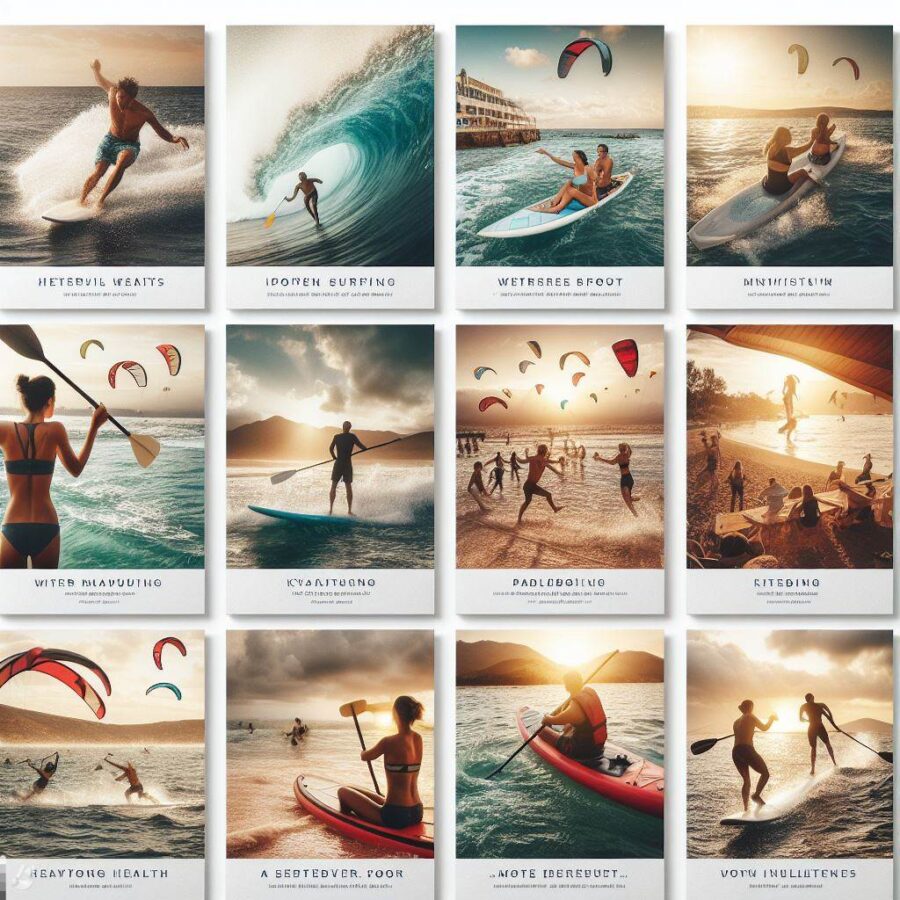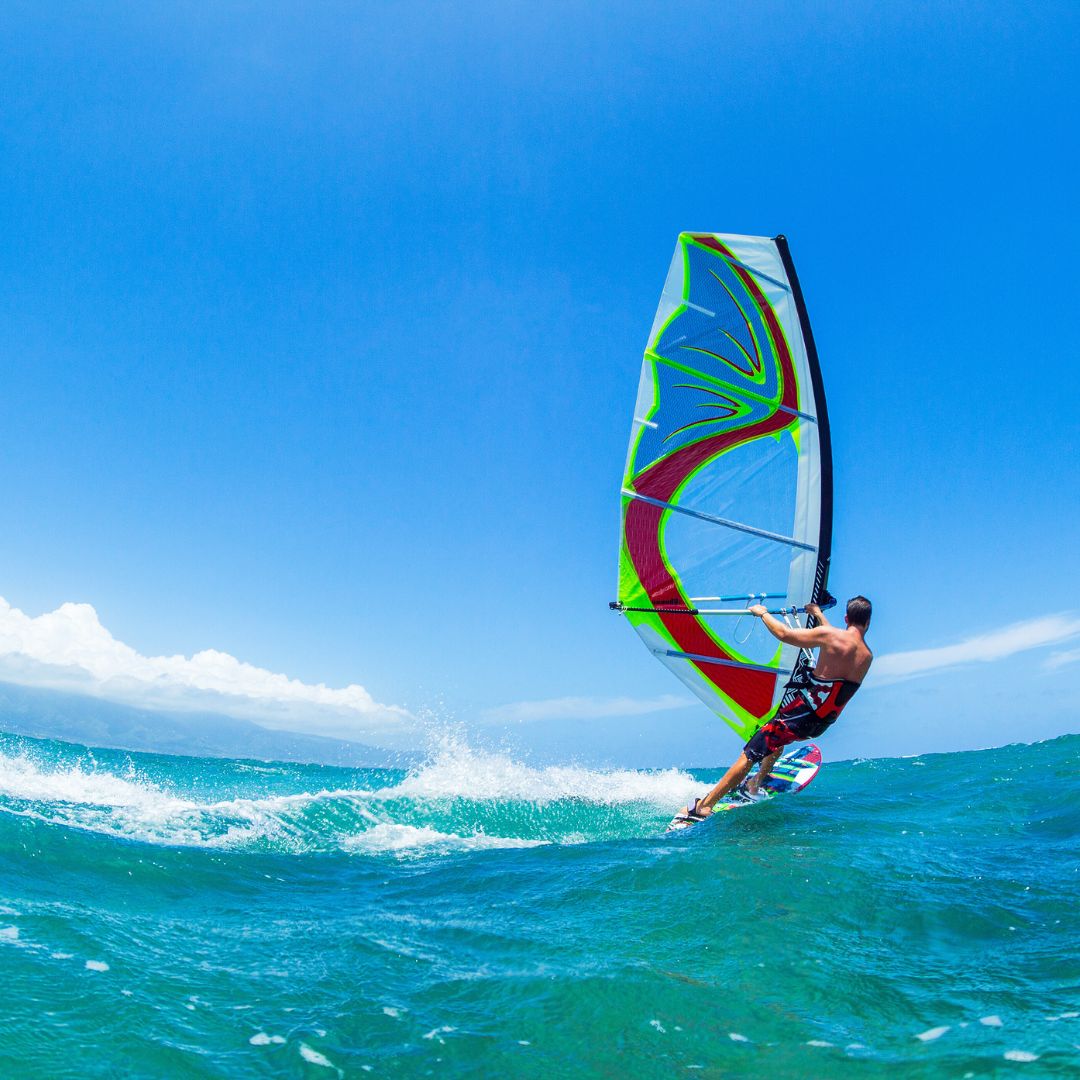Action Water Sports: Ride The Waves, And Conquer New Heights Of Excitement
Action water sports, as the name suggests, are a collection of adrenaline-fueled water activities that will test your limits and leave you exhilarated. They are the perfect escape for those seeking an escape from the mundane and have a taste of pure excitement.
From soaring above the waves on a wakeboard to navigating rapids in a whitewater raft, action water sports offer an unparalleled blend of physical challenge, mental focus, and pure joy. Whether you’re a seasoned adventurer or a curious novice, there’s an action water sport out there waiting to ignite your passion.
This comprehensive guide will delve into the captivating realm of action water sports, exploring the different types, their unique challenges, and the best places to experience them. We’ll also provide tips for beginners and equip you with the knowledge and inspiration to embark on your own action-packed adventures.
What Are Action Water Sports
Action water sports, a dynamic tapestry of aquatic pursuits, beckon enthusiasts to embrace the thrill of adventure amidst the ebb and flow of the open seas. These heart-pounding activities fuse skill, courage, and a deep connection with the water, creating an experience that transcends the ordinary.
From the spirited dance of windsurfing to the rush of navigating white-water rapids, action water sports are a symphony of excitement set against the backdrop of nature’s aquatic playground.
The allure of action water sports lies in the unique blend of challenge and exhilaration they offer. Imagine the rush of wind in your hair as you carve through the waves on a wakeboard or the sheer joy of conquering the surf on a sleek surfboard.
Each splash, twist, and turn becomes a canvas for personal triumph, transforming the water into a realm of boundless possibilities. It’s not just a sport; it’s an immersive experience that captures the essence of adventure, drawing enthusiasts from all walks of life into its aquatic embrace.
Whether you’re a seasoned adventurer or a curious newcomer, the realm of action water sports offers something for everyone.
From the exhilarating rush of surfing to the strategic maneuvering of whitewater rafting, from the gravity-defying stunts of wakeboarding to the serene beauty of stand-up paddleboarding, there’s an activity that will ignite your passion and leave you yearning for more.
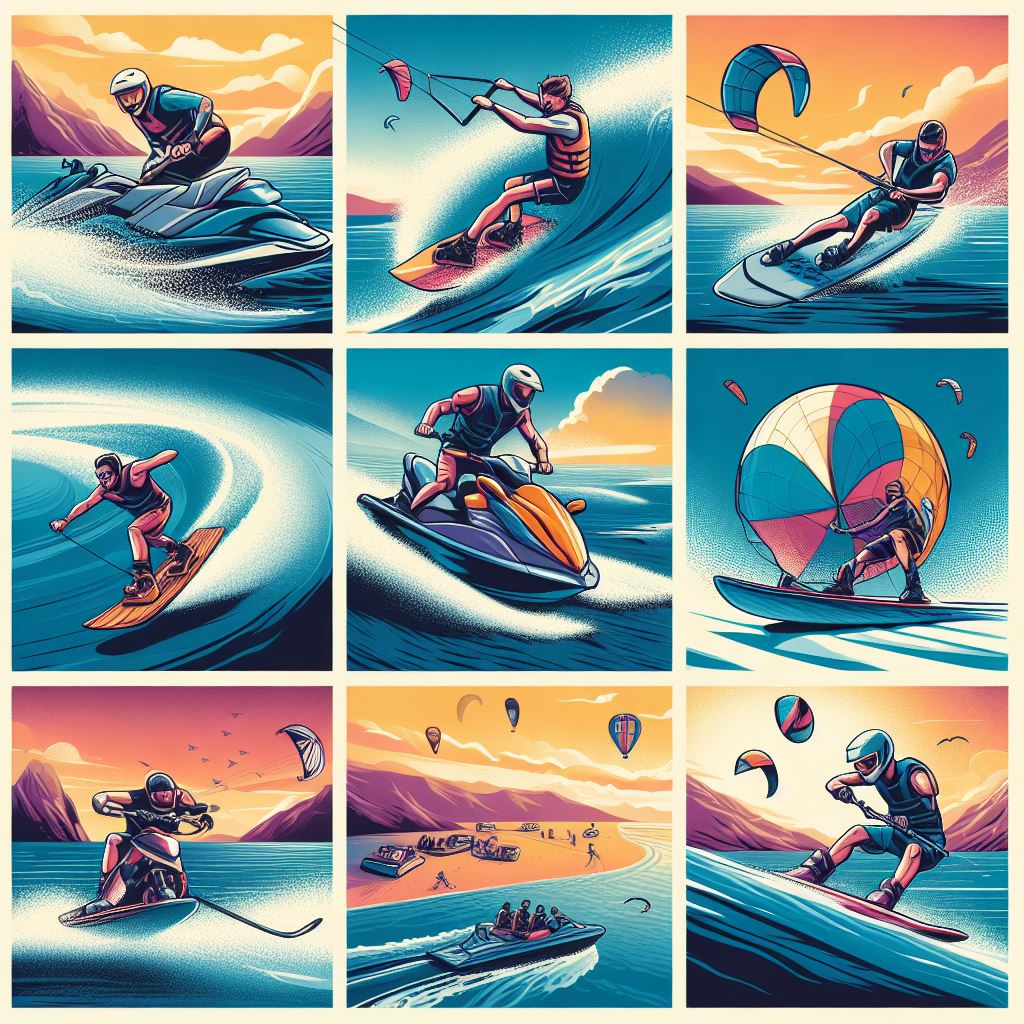
Popular Action Water Sports
1. Wakeboarding
Wakeboarding is an exhilarating water sport that combines the thrill of surfing with the agility of skateboarding. Riders use a tow rope to be pulled behind a boat, generating enough speed to glide across the water’s surface while performing tricks and jumps.
Pros: Wakeboarding combines elements of surfing, snowboarding, and water skiing. It’s relatively easy to learn for beginners, and the community around wakeboarding is vibrant. The feeling of riding the wake behind a boat or cable system is exhilarating.
Challenges: Mastering balance and control can be a challenge, especially for novices. Learning tricks and jumps adds another layer of complexity.
Best Places in the USA: Lake Tahoe in California, Orlando in Florida, and Lake Powell in Arizona are renowned for their pristine waters and excellent wakeboarding conditions.
Essential Equipment: Wakeboard, bindings, water shoes and tow rope.
Safety Gear: Helmet, life jacket, and, if necessary, impact vests.
Importance of Safety Gear: Protects against head injuries and provides buoyancy in case of falls.
2. Jet Skiing
Jet skiing is a high-speed water sport that involves riding a personal watercraft (PWC) across the water’s surface. PWCs are powered by jet engines, allowing you to reach speeds of up to 70 miles per hour.
Pros: Jet skiing provides an adrenaline rush, allowing riders to explore coastlines, lakes, and rivers with speed and agility. It’s easy to learn and is suitable for thrill-seekers of all levels.
Challenges: Maneuvering at high speeds requires skill and awareness of the surroundings. Safety precautions, including proper gear and adherence to water regulations, are crucial.
Best Places in the USA: Key West in Florida, Lake Havasu in Arizona, and Lake Michigan offer fantastic jet skiing opportunities with scenic backdrops.
Essential Equipment: Jet ski, personal watercraft (PWC) key, and fuel.
Safety Gear: Personal flotation device (PFD), wetsuit or drysuit, water shoes and goggles.
Importance of Safety Gear: Ensures buoyancy, protection from cold water, and clear vision.
3. Water Skiing
Water skiing is a classic water sport that involves being towed behind a boat while standing on two skis. Riders use their legs and core muscles to control the skis and perform tricks.
Pros: Water skiing is a classic water sport suitable for all ages. It’s a great full-body workout, enhancing strength and balance. Mastering the basics is relatively quick.
Challenges: Initial balance and learning to get up on skis can be challenging for beginners. Progressing to advanced techniques requires practice.
Best Places in the USA: Lake Tahoe in California, Lake Placid in New York, and Lake Cumberland in Kentucky are popular for water skiing.
Essential Equipment: Water skis, bindings, and tow rope.
Safety Gear: Life jacket, wetsuit or drysuit, and water ski gloves.
Importance of Safety Gear: Enhances buoyancy, protects hands, and ensures visibility.
4. Kiteboarding
Kiteboarding is an extreme water sport that combines the elements of surfing, snowboarding and parasailing. Riders use a harness to attach themselves to a large kite, which provides the power to propel them across the water.
Pros: Kiteboarding combines aspects of surfing and wakeboarding, offering a unique experience. Riding the waves while being propelled by a kite is both thrilling and liberating.
Challenges: Kite control and harnessing wind power demand skill and practice. Safety measures, including understanding wind conditions, are crucial.
Best Places in the USA: Cape Hatteras in North Carolina, Maui in Hawaii, and South Padre Island in Texas are renowned for their kiteboarding-friendly conditions.
Essential Equipment: Kite, control bar, harness, and board.
Safety Gear: Helmet, impact vest, and wetsuit or drysuit.
Importance of Safety Gear: Shields against head injuries, provides extra flotation, and protects against cold water.
5. Windsurfing
Windsurfing is a water sport that combines the elements of surfing and sailing. Riders use a sail to harness the wind’s power, which propels them across the water.
Pros: Windsurfing is a dynamic blend of sailing and surfing, providing an excellent full-body workout. It offers the freedom to explore open waters powered by the wind.
Challenges: Balancing on the board and manipulating the sail require coordination. Learning to harness the wind efficiently is a key skill.
Best Places in the USA: Hood River in Oregon, the Outer Banks in North Carolina, and San Francisco Bay in California are top destinations for windsurfing.
Essential Equipment: Windsurf board, sail, mast, and boom.
Safety Gear: Wetsuit or drysuit, harness, and life jacket.
Importance of Safety Gear: Enhances buoyancy, protects against cold water, and aids in navigation.
6. Surfing
Surfing is a water sport that involves riding waves on a surfboard. Surfers use their body weight and balance to control the board and perform tricks.
Pros: Surfing is an iconic water sport with a culture all its own. Riding the waves on a surfboard provides an unmatched connection with the ocean.
Challenges: Paddling, timing, and catching the right wave demand practice and patience. Progressing to more advanced maneuvers adds complexity.
Best Places in the USA: Malibu in California, Oahu’s North Shore in Hawaii, and New Smyrna Beach in Florida are renowned surf spots.
Essential Equipment: Surfboard and wax.
Safety Gear: Leash, wetsuit or rash guard, and surf helmet (for big wave surfing).
Importance of Safety Gear: Prevents the board from drifting away, provides thermal insulation, and protects the head.
7. White-water Rafting
Whitewater rafting is an adrenaline-pumping water sport that involves navigating through rapids in an inflatable raft. Rafters work together to paddle the raft and avoid obstacles while enjoying the thrill of the ride.
Pros: White-water rafting offers an adrenaline-pumping experience navigating turbulent rivers. It’s a fantastic team-building activity and provides a close encounter with nature.
Challenges: Maneuvering through rapids demands teamwork and paddling skill. Adapting to changing river conditions requires awareness.
Best Places in the USA: The Colorado River in the Grand Canyon, the Salmon River in Idaho, and the Chattooga River in South Carolina are top white-water rafting destinations.
Essential Equipment: Inflatable raft, paddles, and safety rope.
Safety Gear: Helmet, life jacket, wetsuit or drysuit, and river shoes.
Importance of Safety Gear: Guards against head injuries, ensures buoyancy, and protects from cold water.
8. Tubing Behind A Boat
Tubing behind a boat is a fun and easy activity that can be enjoyed by people of all ages. Riders are towed behind a boat on an inflatable tube, experiencing the thrill of the ride as they bounce and glide across the water.
Pros: Tubing is a thrilling water activity suitable for all ages. It requires minimal skill, making it accessible for beginners. The joy of riding an inflatable tube as it skips across the water’s surface, towed by a boat, is unmatched. It’s a fantastic family-friendly activity.
Challenges: While tubing is generally low in skill requirements, the speed and sudden turns can provide an exciting challenge for riders, particularly those seeking a more adventurous experience.
Best Places in the USA: Lake George in New York, the Lake of the Ozarks in Missouri, and Lake Travis in Texas are popular spots for tubing, offering calm waters and picturesque surroundings.
Essential Equipment: Inflatable tube and tow rope.
Safety Gear: Life jacket and helmet.
Importance of Safety Gear: Provides buoyancy and protects the head during unexpected falls.
Whether you seek the rush of speed, the challenge of waves, or the serenity of cruising, these action water sports offer diverse experiences. The USA’s varied landscapes provide the perfect backdrop, ensuring there’s an ideal location for every water sports enthusiast.
RELATED: Is Water Polo The Hardest Sport – Let’s Unravel The Secrets Together!
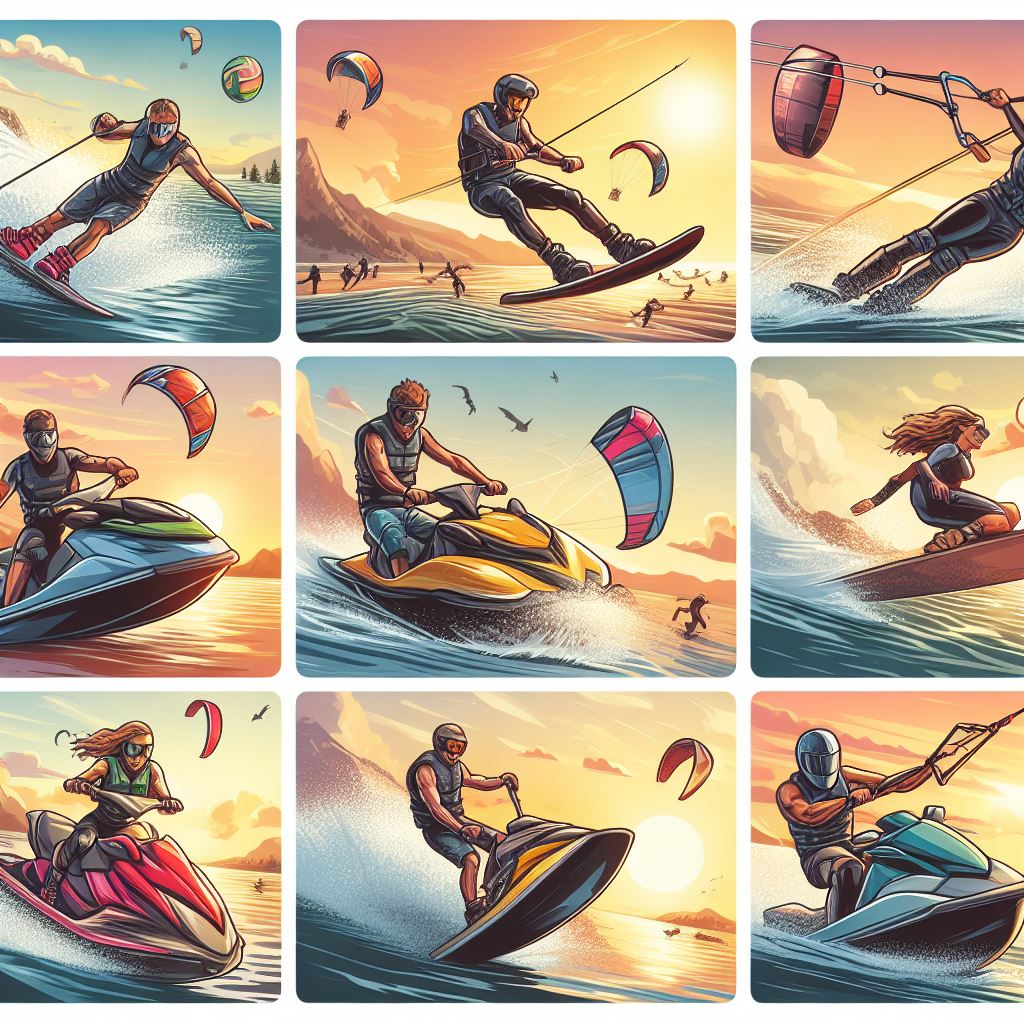
Riding The Waves To Wellness: The Health Benefits Of Action Water Sports
Engaging in action water sports isn’t just about the thrill of the ride; it’s a holistic journey that offers a myriad of physical and mental health benefits. From strengthening muscles to rejuvenating the mind, these aquatic adventures present a unique fusion of fitness and stress relief.
1. Physical Fitness
Wakeboarding: Maneuvering the wake engages core muscles, enhances balance, and promotes overall strength.
Jet Skiing: The dynamic movements while steering the jet ski provide an excellent cardiovascular workout and improve coordination.
Water Skiing: The effort to stay upright on skis targets the legs, while the arms and core are activated during turns.
Kiteboarding: Harnessing the power of the kite engages the entire body, promoting endurance and muscle toning.
Windsurfing: Balancing on the board and controlling the sail build core strength and improve flexibility.
Surfing: Paddling, popping up on the board, and riding waves work the upper body, legs, and cardiovascular system.
White-water Rafting: Paddling through rapids provides an intense full-body workout, enhancing strength and endurance.
Tubing: Holding on to the tube and navigating waters engages the upper body, particularly the arms.
2. Mental Well-being
Stress Relief: The combination of the rhythmic sounds of water, the fresh air, and the thrill of the activity promotes stress relief and relaxation.
Mindfulness: Being in the present moment, attuned to the water’s movement and the challenges of the sport, fosters mindfulness.
Adrenaline Release: The excitement and adrenaline rush associated with action water sports contribute to a positive mood and reduced stress.
Connection with Nature: Immersing oneself in natural surroundings while participating in these activities enhances mental well-being and reduces anxiety.
3. Social Engagement
Community Bonding: Many action water sports have vibrant communities, fostering social connections and a sense of belonging.
Team Activities: White-water rafting, for example, promotes teamwork and communication, enhancing interpersonal skills.
Shared Experiences: Sharing the joy of riding waves or navigating rapids creates lasting bonds and positive social interactions.
4. Cardiovascular Health
Increased Heart Rate: The dynamic nature of these sports elevates heart rate, contributing to improved cardiovascular health.
Calorie Burning: The effort required in activities like wakeboarding, jet skiing, and kiteboarding aids in weight management.
Whether you’re chasing the perfect wave or navigating challenging rapids, the health benefits of action water sports extend beyond the physical realm. They offer a holistic approach to well-being, promoting both physical fitness and mental resilience, making every adventure on the water a step towards a healthier, happier life.
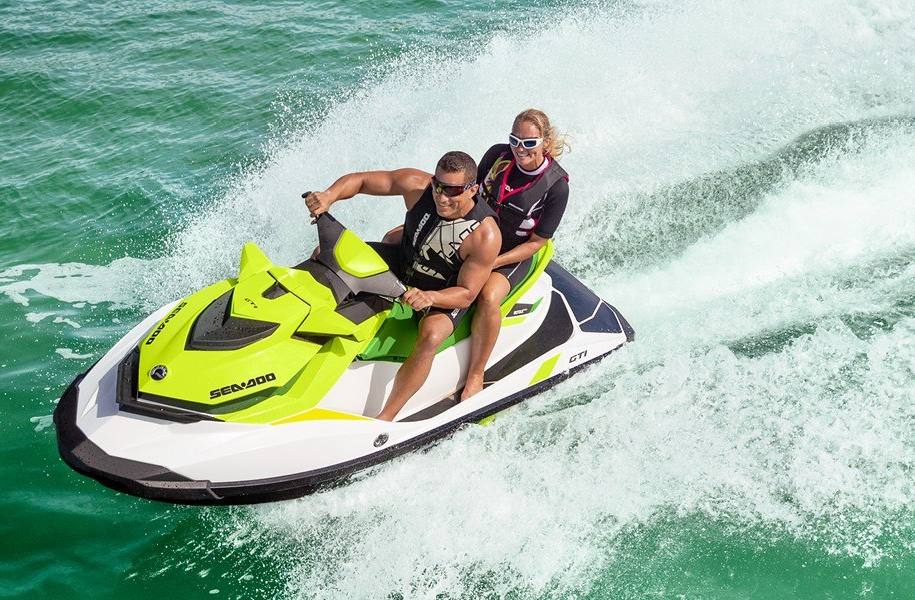
Training And Skill Development In Action Water Sports
Embarking on the thrilling journey of action water sports requires more than just enthusiasm; it demands a foundation of skills and knowledge to navigate the waves safely.
Whether you’re a novice eager to try your hand at wakeboarding or an aspiring surfer ready to conquer the swell, understanding the basics and investing in professional training are crucial steps toward a rewarding and secure water adventure.
1. Wakeboarding Training
Basics: Begin with proper body positioning and balance. Learn to handle the tow rope and practice getting up on the wakeboard.
Tips for Beginners: Keep your knees slightly bent, distribute weight evenly, and focus on a steady posture. Start with a slow boat speed to build confidence.
Professional Training: Enroll in wakeboarding lessons to receive guidance on technique, safety, and progression to advanced maneuvers.
2. Jet Skiing
Basics: Familiarize yourself with jet ski controls, steering, and throttle. Learn proper mounting and dismounting techniques.
Tips for Beginners: Start in calm waters, practice turning and stopping, and gradually increase speed. Keep a safe distance from other watercraft.
Professional Training: Certified instructors can teach essential skills, safety protocols, and advanced maneuvers for a more enjoyable experience.
3. Water Skiing
Basics: Master the art of getting up on skis and maintaining balance. Learn to control speed and direction by shifting weight.
Tips for Beginners: Keep skis parallel, maintain a slight knee bend, and keep arms straight. Practice deep-water starts for a smoother ride.
Professional Training: Lessons with experienced instructors enhance technique, teach advanced tricks, and emphasize safety measures.
4. Kiteboarding
Basics: Understand kite control, body dragging, and board control. Learn to ride in both directions and perform basic turns.
Tips for Beginners: Practice flying the kite on land first. Start in light winds, use a suitable-sized kite, and focus on body positioning.
Professional Training: Certified kiteboarding instructors provide comprehensive training on safety, kite control, and progression to advanced maneuvers.
5. Windsurfing
Basics: Grasp the fundamentals of balance on the board, sail control, and steering. Learn to harness the wind for propulsion.
Tips for Beginners: Begin in light winds, practice board control on land, and gradually progress to open water. Focus on mastering turns and maintaining balance.
Professional Training: Enroll in windsurfing lessons to accelerate skill development, receive safety guidance, and refine technique.
6. Surfing
Basics: Start with paddling techniques, mastering the “pop-up” to stand on the board, and learning to catch small waves.
Tips for Beginners: Begin on a large, stable board. Practice paddling and “pop-ups” on land before hitting the waves. Choose beginner-friendly surf spots.
Professional Training: Surf schools offer lessons on wave selection, board control, and ocean safety.
7. White-water Rafting
Basics: Understand paddling techniques, commands from the guide, and proper rafting positions. Learn to navigate different classes of rapids.
Tips for Beginners: Follow the guide’s instructions, practice effective communication with the team, and familiarize yourself with rafting signals.
Professional Training: Guided trips with certified rafting guides provide hands-on experience, safety training, and exposure to various river conditions.
8. Tubing
Basics: Grab hold of the tube’s handles, position yourself properly, and communicate with the boat driver for a thrilling ride.
Tips for Beginners: Start with gentler speeds, focus on maintaining a firm grip, and communicate with the boat driver about your comfort level.
Professional Training: While tubing is often considered a more casual activity, beginners can benefit from basic safety guidelines and tips from experienced boat drivers.
Investing in professional training not only accelerates skill development but also instills a deep understanding of safety protocols, water etiquette, and environmental awareness.
Whether you’re a beginner seeking the fundamentals or an experienced enthusiast aiming for mastery, training ensures a smoother, safer, and more enjoyable experience in the world of action water sports.
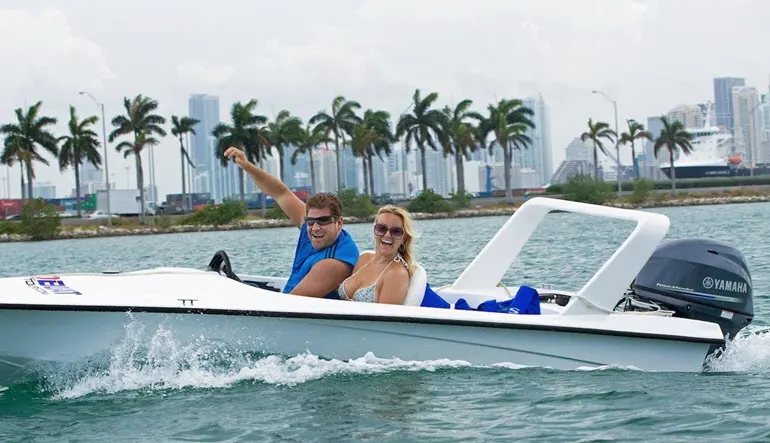
Safety Precautions: Navigating the Waters of Action Water Sports
Engaging in the adrenaline-fueled world of action water sports is undeniably thrilling, but it comes with a responsibility to prioritize safety above all else.
Whether you’re carving waves on a surfboard or tackling the rapids in a white-water raft, understanding and adhering to essential safety precautions is paramount to ensuring a secure and enjoyable aquatic adventure.
1. Wear Appropriate Safety Gear
Life Jackets: Always wear a properly fitted life jacket. It’s your most crucial piece of safety equipment and provides buoyancy in case of falls.
Helmets: In sports like wakeboarding, kiteboarding, and white-water rafting, helmets protect against head injuries in the event of collisions or falls.
2. Know Your Limits
Start Slow: If you’re a beginner, start with easier and less challenging conditions. Gradually progress as you gain skills and confidence.
Weather Awareness: Be aware of weather conditions. High winds, storms, or rough seas can significantly impact the safety of your activity.
3. Undergo Professional Training
Certified Instructors: Enroll in lessons with certified instructors to learn proper techniques, safety measures, and emergency procedures.
Skill Progression: Gradually progress from beginner to advanced levels, ensuring a solid foundation before attempting more challenging maneuvers.
4. Check Equipment Regularly
Inspect Gear: Before each session, inspect your equipment for any signs of wear or damage. Faulty gear can lead to accidents.
Maintain Equipment: Follow maintenance guidelines for your equipment to ensure it functions properly.
5. Follow Water Regulations
Know the Rules: Familiarize yourself with waterway rules and regulations. Different areas may have specific guidelines for water sports activities.
Respect Other Water Users: Be aware of other boats, swimmers, or surfers in the vicinity and adhere to right-of-way rules.
6. Buddy System
Never Solo: Whenever possible, engage in water sports with a buddy. Having someone nearby can be crucial in case of emergencies.
Communication: Establish clear communication signals with your buddy, especially in activities like diving or kiteboarding where non-verbal cues are essential.
7. Stay Hydrated and Energized
Hydration: Dehydration can impair judgment and reaction time. Ensure you stay hydrated, especially in warm weather.
Nutrition: Eat a balanced meal before engaging in water sports to maintain energy levels.
8. Be Mindful of the Environment
Protect Marine Life: Avoid disturbing marine life, coral reefs, or sensitive ecosystems. Be conscious of the impact your activities may have on the environment.
Respect Wildlife: Maintain a safe distance from marine animals. Do not provoke or interfere with their natural behavior.
9. Emergency Preparedness
Know Emergency Procedures: Understand and practice emergency procedures specific to your activity. This includes knowing how to signal for help.
Carry Communication Devices: In remote areas, carry communication devices such as a waterproof phone pouch or radio for emergencies.
10. Listen to Local Experts
Local Knowledge: Seek advice from locals or experienced individuals familiar with the area. They can provide insights into local conditions and hazards.
Guided Tours: For activities like white-water rafting or diving, consider guided tours led by experienced professionals who know the terrain.
Prioritizing safety in action water sports isn’t just a recommendation; it’s an absolute necessity. By adhering to these precautions and fostering a culture of responsible enjoyment, you can savor the thrill of aquatic adventures while ensuring a secure and memorable experience on the water.
Community And Events – Dive Into The Thriving World Of Water Sports
Beyond the rush of the waves and the thrill of the ride, the world of water sports boasts vibrant communities that share a passion for aquatic adventure.
Whether you’re a seasoned pro or dipping your toes into the water for the first time, connecting with these communities can amplify your experience, providing camaraderie, shared knowledge, and the chance to participate in exciting events.
1. Join Local Clubs
Networking: Seek out local water sports clubs or organizations in your area. These communities often organize regular meet-ups, training sessions, and social events.
Skill Exchange: Being part of a club allows you to exchange tips and techniques with experienced individuals, fostering skill development and a sense of camaraderie.
2. Participate in Water Sports Events
Local Competitions: Many communities host local water sports competitions. These events are not just about showcasing skills but also celebrating the joy of the sport with fellow enthusiasts.
Spectator Opportunities: Attend events as a spectator to witness professionals in action, learn new techniques, and immerse yourself in the infectious energy of the community.
3. Online Communities
Forums and Social Media: Explore online forums and social media groups dedicated to specific water sports. These platforms provide a space for discussions, advice sharing, and connecting with enthusiasts globally.
Virtual Events: Participate in virtual events, webinars, or online challenges organized by these communities, allowing you to engage with like-minded individuals from the comfort of your home.
4. Community Outreach Programs
Inclusivity: Many water sports communities are actively involved in outreach programs to make these activities accessible to a broader audience. Get involved in initiatives that promote inclusivity and introduce water sports to diverse communities.
5. Environmental Conservation Initiatives
Community Impact: Joining a water sports community often means contributing to environmental initiatives. Many communities are actively involved in beach clean-ups, marine conservation efforts, and raising awareness about protecting aquatic ecosystems.
Stewardship: Being part of a community allows you to take an active role in stewardship, ensuring that the environments where these sports thrive are preserved for future generations.
6. Group Excursions
Explore Together: Plan group excursions or trips with your water sports community. Exploring new locations together adds a social dimension to your adventures and creates lasting memories.
Safety in Numbers: Group activities enhance safety, particularly when engaging in activities like snorkeling, diving, or white-water rafting.
7. Training Camps and Workshops
Skill Enhancement: Communities often organize training camps and workshops conducted by experienced instructors. These events provide opportunities for skill enhancement and learning advanced techniques.
Continuous Learning: Engaging with the community ensures that you stay updated on the latest trends, gear, and safety protocols through shared experiences and knowledge.
By immersing yourself in water sports communities, you not only enrich your personal journey but also become part of a network that fosters a love for the ocean, rivers, and lakes.
Joining clubs, participating in events, and connecting with like-minded individuals amplifies the joy of water sports, turning each adventure into a shared celebration of the sea’s boundless wonders. Dive in, connect, and ride the waves together!
Environmental Awareness Fostering – Environmental Awareness In Water Sports
As avid enthusiasts of water sports, it’s incumbent upon us to be stewards of the very environments that provide us with exhilarating experiences.
The impact of our actions on the oceans, lakes, and rivers is significant, and fostering environmental awareness is crucial to ensure the longevity of these precious ecosystems.
Let’s explore how we can enjoy our water adventures responsibly and contribute to the preservation of the environments we hold dear.
1. Mindful Gear Choices
Eco-friendly Materials: Opt for water sports equipment and gear made from sustainable, eco-friendly materials. From wetsuits to surfboards, choices that prioritize the environment contribute to a healthier planet.
Minimal Packaging: When purchasing gear, choose products with minimal or sustainable packaging to reduce waste.
2. Responsible Waste Management
Pack it Out: Whether you’re on a rafting trip or a beach day, always carry a waterproof bag to collect and dispose of your waste properly.
Participate in Clean-up Initiatives: Join or organize beach clean-ups and river clean-up events to address existing pollution and prevent further environmental degradation.
3. Mindful Anchoring and Navigation
Avoid Sensitive Areas: When engaging in water activities, avoid areas with delicate ecosystems such as coral reefs and seagrass beds. Anchor only in designated areas.
Mindful Navigation: Follow marked waterways to avoid damaging underwater habitats. In shallow areas, use a paddle or pole instead of a motor to prevent disturbances.
4. Limit Chemical Usage
Eco-friendly Sunscreen: Choose reef-safe and eco-friendly sunscreens to protect yourself without harming marine life.
Biodegradable Soaps: Use biodegradable soaps when cleaning gear or yourself to minimize the impact on water quality.
5. Educate and Inspire
Community Awareness: Share information within water sports communities about the environmental impact of certain activities. Foster a culture of responsibility and respect for nature.
Educational Initiatives: Organize workshops or educational sessions to enlighten enthusiasts about the ecosystems they engage with and how their actions can contribute to conservation efforts.
6. Advocate for Conservation
Support Marine Conservation Organizations: Contribute to or support organizations working towards the conservation of marine and freshwater ecosystems.
Policy Advocacy: Stay informed about environmental policies related to water sports areas and advocate for regulations that promote sustainability.
7. Leave No Trace
Camp Responsibly: If your water adventure involves camping, adhere to the principles of Leave No Trace. Minimize your impact on the environment by following responsible camping practices.
Respect Wildlife: Observe marine and aquatic life from a safe distance. Do not disturb or feed wildlife and avoid touching coral reefs and sensitive ecosystems.
8. Sustainable Transportation
Eco-friendly Watercraft: Choose eco-friendly watercraft options, such as electric-powered boats or paddleboards, to minimize the environmental impact of your transportation.
Carpooling: When heading to water sports destinations, consider carpooling to reduce carbon emissions.
By adopting responsible and eco-friendly practices, we can ensure that the beauty and biodiversity of our water environments endure for generations to come.
Each water sports enthusiast has the power to become a guardian of the waves, promoting environmental awareness and leaving a positive legacy for the waters we cherish. Let’s ride the waves responsibly, leaving only ripples of enjoyment in our wake.
Action Water Sports Boats
Action water sports boats are specialized watercraft designed to enhance and facilitate various thrilling water activities. These boats are equipped with features that cater to the needs of specific water sports, providing the power, speed, and maneuverability required for an exhilarating experience. Here are some types of boats commonly used in action water sports:
1. Wakeboard Boats: Specifically designed for wakeboarding, these boats have features like wakeboard towers and ballast systems to create large, consistent wakes for riders to perform tricks and jumps.
2. Jet Boats: Jet boats are powered by jet propulsion instead of traditional propellers. They are well-suited for activities like jet skiing, providing agility, speed, and the ability to navigate in shallow waters.
3. Ski Boats: Ideal for water skiing, these boats are designed to provide a smooth, consistent pull for skiers. They often have a specialized tow pylon or ski/wakeboard tower.
4. Powerboats for Kiteboarding: Kiteboarders typically use powerboats to tow them into the wind, generating the power needed to ride and perform tricks with a kite. These boats need to be powerful and responsive.
5. Windsurfing Support Boats: Boats used in windsurfing provide support to windsurfers on the water. They often carry additional equipment, provide a stable platform for learning, and assist with rescues if needed.
6. Surf Boats: Specialized boats for wakesurfing create a surfable wake without the need for a towrope. They typically have advanced ballast systems, hull designs, and surf systems to shape and customize the wave.
7. Inflatable Boats for White-water Rafting: In white-water rafting, inflatable boats, often called rafts, are used to navigate through rapids. These boats are designed to be durable, stable, and able to withstand the challenges of turbulent rivers.
8. Pontoon Boats for Tubing: Pontoon boats are sometimes used for tubing activities. They provide stability and space for multiple riders. The flat deck is suitable for towing inflatable tubes.
When selecting a boat for action water sports, it’s essential to consider factors like the specific sport, boat size, engine power, and additional features tailored to the activity.
Safety is paramount, so ensure that the boat meets safety standards and regulations for the chosen water sport. Additionally, always follow proper operating procedures and guidelines to ensure a safe and enjoyable experience on the water.
Action Water Sports Tahoe
Lake Tahoe, straddling the border of California and Nevada, is a stunning freshwater lake known for its crystal-clear waters and breathtaking mountainous surroundings. The lake offers a variety of opportunities for action water sports, catering to enthusiasts seeking adventure and thrill. Here are some popular action water sports you can enjoy in the Lake Tahoe region:
- Wakeboarding: Lake Tahoe’s expansive waters provide ample space for wakeboarding. Rent or bring your wakeboard and experience the excitement of riding the lake’s wakes.
- Jet Skiing: Rent a jet ski and explore the vastness of Lake Tahoe. Jet skiing allows you to cover a lot of water and enjoy the stunning scenery surrounding the lake.
- Water Skiing: Glide across the pristine waters of Lake Tahoe with water skiing. The lake’s clear and calm conditions make it an ideal spot for both beginners and experienced water skiers.
- Kiteboarding: Take advantage of the wind currents over Lake Tahoe for kiteboarding. The lake’s scenic beauty combined with the thrill of kiteboarding creates a unique and exhilarating experience.
- Windsurfing: With consistent winds, Lake Tahoe provides excellent conditions for windsurfing. Rent equipment or bring your own to harness the wind and ride the waves.
- Stand-Up Paddleboarding (SUP): Enjoy a more relaxed water activity by trying stand-up paddleboarding on Lake Tahoe. Explore the calm waters and take in the stunning views at your own pace.
- Surfing: While Lake Tahoe is not an ocean, you can still experience surfing on the lake. Wakesurfing, using the boat’s wake to surf, is a popular activity on the lake.
- White-water Rafting: For a thrilling adventure, consider taking a white-water rafting trip on the nearby Truckee River. The river offers a range of rapids suitable for different skill levels.
- Parasailing: Soar above Lake Tahoe and take in panoramic views by trying parasailing. It’s a unique way to experience the beauty of the lake from a different perspective.
- Tubing: Enjoy a more laid-back water activity by tubing on Lake Tahoe. Get pulled behind a boat and experience the fun and excitement of being towed on an inflatable tube.
Before engaging in any action water sport on Lake Tahoe, it’s essential to be aware of local regulations, safety guidelines, and weather conditions. Many rental facilities and tour operators around the lake offer equipment and guided experiences for various water sports.
Whether you’re an adrenaline junkie or seeking a more leisurely water experience, Lake Tahoe provides a stunning backdrop for a wide range of action water sports.
Frequently Asked Questions For Action Water Sports And Troubleshooting Guide For Beginners
What Water Sport Is Best For Beginners?
For beginners, activities like paddleboarding, tubing, or kayaking are excellent choices. They provide a gentle introduction to water sports, allowing you to build confidence and basic skills.
How Do I Choose The Right Equipment?
Consult with experienced individuals or instructors when selecting equipment. Consider factors like your skill level, the type of water sport, and the conditions of the water body you’ll be in.
What Safety Precautions Should I Take?
Always wear a life jacket, undergo professional training, be aware of weather conditions, and follow water regulations. Knowing how to swim is essential, and never engage in water sports alone.
How Can I Overcome Fear Or Anxiety In The Water?
Start slowly in calm waters, practice deep breathing, and gradually expose yourself to more challenging conditions. Taking lessons from certified instructors can also boost confidence.
What If I Get Tired Quickly During Water Sports?
Build stamina gradually. Stay hydrated, take breaks, and listen to your body. Consider incorporating cardiovascular exercises into your routine to improve endurance.
How Can I Avoid Motion Sickness In Activities Like Kayaking Or Paddleboarding?
Focus on a fixed point on the horizon, maintain proper posture, and avoid excessive head movements. Gradually increase the duration of your sessions to build tolerance.
What Should I Do If I Fall Off My Board Or Watercraft?
Remain calm, float on your back, and retrieve your board or watercraft. If in a group, signal for assistance. In activities like surfing, practice “turtle rolling” to navigate waves and avoid getting hit by your board.
How Do I Handle Strong Currents Or Waves?
Stay calm and conserve energy. Float on your back if necessary and signal for help. For activities like surfing or bodyboarding, learn to read and navigate waves gradually.
Difficulty Maintaining Balance On A Paddleboard Or Surfboard?
Solution: Practice balance on land first. Start in calm, flat waters, and use a wider, more stable board. Keep your center of gravity low and engage your core for stability.
Jet Ski Or Boat Engine Trouble?
Check fuel levels, ensure the kill switch is not engaged, and inspect for any visible issues. If problems persist, seek professional assistance and never attempt to fix the engine while on the water.
Uncomfortable Chafing From Wetsuit Or Harness?
Use anti-chafing products, ensure a proper fit, and consider adjusting the tightness of the harness or wetsuit. Address any rubbing points before they become painful.
Difficulty Steering A Kayak Or Paddleboard?
Check your paddle technique, ensuring you paddle on both sides evenly. For kayaking, use proper strokes and body rotation. If the issue persists, consider taking a beginner’s paddling course.
Watercraft Or Board Taking On Water?
Inspect for any visible damage, check seals and closures, and ensure drain plugs are securely in place. Seek professional help for repairs if necessary.
Overcoming Fear Of Open Water Or Deep Areas?
Gradually expose yourself to deeper waters, starting in shallow areas. Take gradual steps, practice controlled breathing, and consider taking swim lessons to build confidence.
The Bottom Line On Action Water Sports
In the realm of action water sports, every splash tells a story of exhilaration and adventure. As you embark on the journey of riding waves, conquering currents, and feeling the rush of wind against your face, remember that each moment is a brushstroke on the canvas of unforgettable experiences.
Whether you’re a seasoned enthusiast or a curious beginner, the world of action water sports beckons with a promise of heart-pounding excitement, breathtaking vistas, and a tapestry of memories waiting to be woven.
